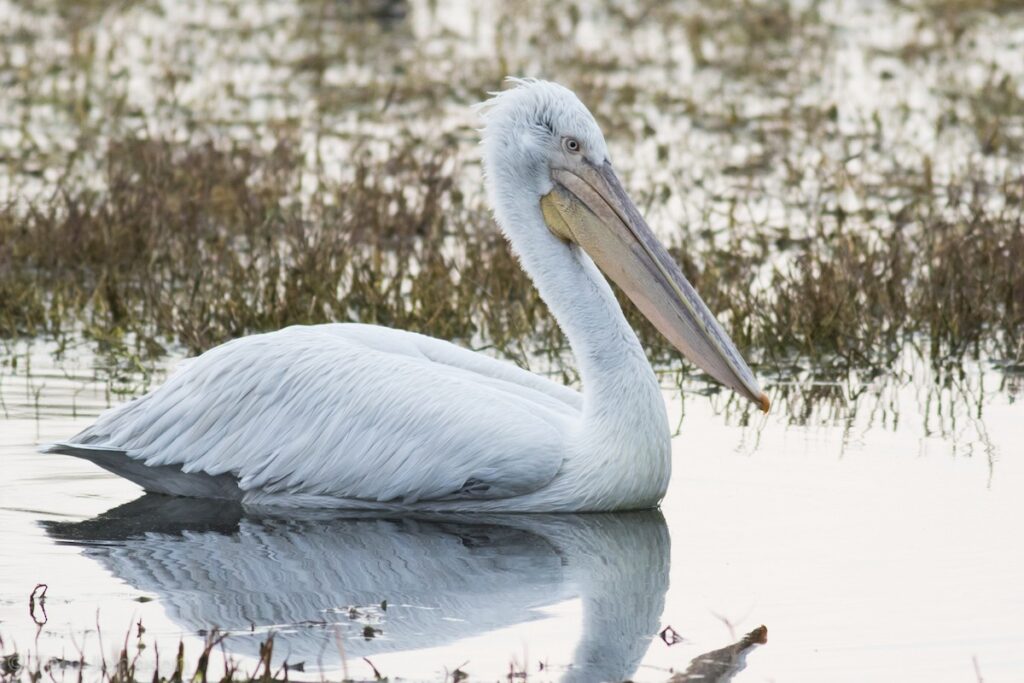Family: Pelecanidae
Genus: Pelecanus
The massive pelican stands out with its disheveled look, featuring a dirty white plumage and a scruffy, upswept crest. Its black primaries become prominent during flight, adding to its distinctive appearance. During the breeding season, adults showcase a bright orange pouch, which turns yellow when not breeding. While it might be mistaken for the Spot-billed Pelican or the Great White Pelican, it can be identified by its pale iris, clean bill without spots, and gray legs. This pelican loves to hang out by rivers, expansive wetlands, and estuaries, often gathering in large, social flocks.
Photo: Look how gorgeous [myshortcode]
Take a look at [myshortcode]
Description [myshortcode]
 The Dalmatian Pelican (Pelecanus crispus) is a remarkable bird known for its significant size and distinctive features. Widely distributed across southeastern Europe and central Asia, this pelican is one of the heaviest flying birds, making it a fascinating subject for bird enthusiasts and conservationists alike.
The Dalmatian Pelican (Pelecanus crispus) is a remarkable bird known for its significant size and distinctive features. Widely distributed across southeastern Europe and central Asia, this pelican is one of the heaviest flying birds, making it a fascinating subject for bird enthusiasts and conservationists alike.
Dalmatian Pelicans prefer wetland habitats, such as swamps, lakes, and deltas, where they find abundant fishing opportunities. They are predominantly found in freshwater environments but are also known to inhabit brackish waters. Key breeding populations are located in countries like Greece, Bulgaria, Romania, Russia, and Mongolia. During winter, these birds migrate to warmer regions, including the Middle East, the Indian subcontinent, and southeastern China.
Physically, Dalmatian Pelicans are notable for their large size, with a length ranging from 160 to 183 cm, a wingspan of 245 to 351 cm, and a weight between 7.25 to 15 kg. They have a disheveled appearance due to their ruffled feathers and a distinctive upswept crest. Their plumage is primarily white, with black primaries that become prominent in flight. During the breeding season, their pouch turns bright orange, shifting to yellow in the nonbreeding season. Nonbreeding adults exhibit a bright white face and neck with a dark line through the eye.
These pelicans are highly social, often forming large, noisy colonies. They build nests on the ground in reed beds or on islands, showcasing their preference for wetlands with shallow waters. Dalmatian Pelicans are proficient hunters, feeding primarily on fish. They use their large bills and expandable throat pouches to scoop up fish, often hunting in coordinated groups to corral fish into shallow waters.
Despite their impressive presence, Dalmatian Pelicans face threats from habitat loss, disturbance, and pollution. They are currently classified as Near Threatened on the IUCN Red List. Conservation efforts are essential to protect their habitats and ensure the survival of this majestic species. Overall, the Dalmatian Pelican’s distinctive appearance, social behavior, and migratory patterns make it a captivating bird, highlighting the importance of wetland conservation.





